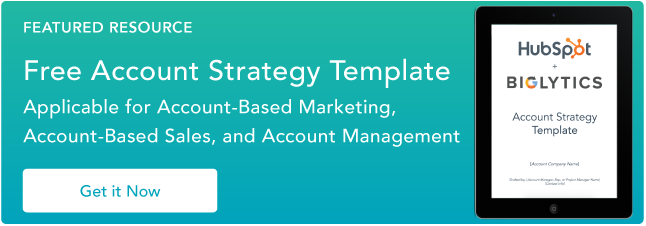Are you a B2B account manager or sales executive serious about account-based marketing (ABM)? If the answer is “yes,” chances are you understand your customers want partners, not vendors.

To win new business and grow key accounts, account managers and sales executives must become invested in their customer’s challenges, goals, and the competitive landscape in which their business operates.
By using strategic account planning to target your key accounts, you can become your customer’s trusted partner by solving problems instead of selling products.
This article will touch on two viable account planning solutions — account-based marketing software and a manual, template-based approach. Below, we share one of the best templates to begin the account planning process in your sales organization.

Strategic Account Plan Template Layout
If you're reluctant to invest in ABM software or just want a solid starting point to understand ABM strategy better, this strategic account planning template will help you:
- Expand your understanding of your customer’s business, goals, and motivations
- Deliver value through right-fit solutions to their toughest challenges
- Navigate internal politics and target key stakeholders to drive buy-in
- Identify and avoid risks, barriers, and limitations
Featured Resource: Strategic Account Planning Template
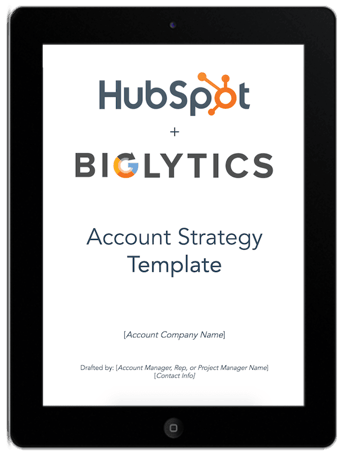
Download This Template for Free
Ready to explore what account planning is all about and how it can increase your sales? In this article, we’ll go over the following topics:
- What is account planning?
- Terms related to account planning
- Account planning process: a step-by-step guide
- Account planning templates
- Account-based marketing software
Let’s get started.
What is Account Planning?
Account planning, used primarily in B2B sales, is the process of nurturing and growing your existing customer relationships. When creating an account plan, you seek to understand your customer’s business by identifying their key initiatives, problems, and challenges. Your objective is to deliver value that helps them achieve their goals and increase their sales.
Account planning is about partnering with your customer instead of selling to your customer. It looks at sales not as a transactional process but as the start of a strategic partnership. This term is usually applicable in B2B organizations rather than B2C organizations.
Because account planning is such a thorough process, it allows you to ask your customer highly specific questions related to their business and challenges.
These questions are usually related to the product or service you offer, giving you further insight into how you can solve for them in both the short and long term.
While account planning aims to decrease customer attrition, it can also be a valuable tool for acquisition. Understanding your most profitable customers can help you identify better prospects to target in your future sales efforts.
Account Plan
An account plan is a document that outlines all pertinent information about your customer, including their business goals, challenges, priorities, competitors, decision-making processes, and purchase criteria. You can also detail your strategies for retaining and upselling them.
The information you gather for your account plan will give you valuable insight into your customer's priorities. This constant flow of helpful information makes it easier to be proactive in fulfilling the client's needs.
Efficient implementation takes a lot of trial and error, but when you have the right data as a starting point, the trial period gets shorter and easy to overcome. Knowing what your clients want is a good way to ensure that your account planning efforts will be more effective from the beginning.
.png)
Free Account Management Template
A strategic template for your account-based marketing, sales, and management.
- Key Business Initiatives
- Account Competitor Analysis
- Sales Opportunities, Targets & Risks
- And More!
Free Account Planning Worksheet
Fill out the form to access your free template.
In addition, by offering this type of value, customers are happy and more likely to be loyal to your organization. Your objective is to deliver value that helps them achieve their goals and increase sales.
An effective account planning strategy will help your company build a reputation as a solution provider that customers can trust. To build an effective account strategy, account professionals must become invested in their customer’s challenges, goals, and the competitive landscape in which their business operates.
Account Planning and Marketing Strategies
Knowing what your customers appreciate and expect from your services is a strong foundation for your marketing efforts. Marketing is not only about putting your work out there but also about taking your audience’s language and communicating what they actually need to hear. This is where account planning comes in.
Account planning helps any marketing team turn business data into effective creative work that satisfies your customers and leads.
A marketing strategy aimed at transforming pain points into strong assets creates a strong customer relationship based on value and efficiency rather than a plain sales process.
Why is Account Planning important?
87% of marketers say account-based marketing outperforms other marketing activities. As such, it’s vital to learn how it can help your business too.
Here are some of account planning’s most significant benefits.
Reduces Acquisition Costs
Customer acquisition is expensive for several reasons. Some of the major costs are incurred from the resources expended to discover customer drivers and challenges.
Account planning reduces acquisition costs because it allows you to focus more on creating business through existing customers instead of looking for new ones.
Speeds Up Sales
Account planning reduces acquisition costs and makes it easier to close deals faster. In addition, since account planning focuses on existing accounts, sales professionals already know the key decision-makers in the buying process and understand how they prefer to buy.
Furthermore, account planning helps sales professionals observe customer behaviors that can be disruptive to the buying process.
Retains Important Relationships
Since account planning involves frequent communication between clients and representatives, your sales professionals are positioned to get the real-time pulse of clients.
An effective account plan helps businesses nurture existing relationships with customers while also providing a solid base for future marketing efforts. If account planning plays an essential role in client retention outcomes and conversion rates, it affects the company's overall number of clients (and revenue).
Working on your account planning will reduce acquisition costs while making it easier to close deals faster. Since account planning focuses on existing accounts, sales professionals already know the key decision-makers in the buying process and understand how they prefer to buy.
When account planning is optimized, sales strategies will have a new foundation full of valuable data. This will help sales workers ensure that all their efforts are going in the right direction.
By reducing acquisition costs and speeding up sales, account planning can be the first step in successfully using your business resources, especially time and money. It provides the information needed to build solid foundations for your client’s relationships and your sales work.
Account planning can be a great way to level up your business sales and customer satisfaction rates, but it can be difficult to start implementing its steps. Having the right guides and resources is essential for any business process.
.png)
Free Account Management Template
A strategic template for your account-based marketing, sales, and management.
- Key Business Initiatives
- Account Competitor Analysis
- Sales Opportunities, Targets & Risks
- And More!
Related Account Planning Terms
Now, let’s talk about some of the common terms you’ll find while scrolling through any account planning article.
Sales Account Planning
Sales account planning is an alternative term for account planning. This account planning approach process takes all the information about customer behavior and focuses on improving sales processes. With a special focus on converting users into customers, sales account planning will have a strong lead generation potential. However, customer retention strategies won’t have a special place in this process.
Strategic Account Management
Choosing high-value and high-profit accounts to grow and nurture is called strategic account management. Not all accounts or customers warrant a plan, so strategic account managers typically spearhead these efforts. Thus, account planning and strategic account management can go hand-in-hand.
Key Account Management
Key account management is similar to strategic account management and may also complement the account planning process. Sales leaders and representatives build, maintain, and nurture the business’s most profitable accounts. They do this by offering exclusive resources, recurring meetings, and dedicated key account managers (KAMs).
Account-based Marketing
Account-based marketing is usually carried out after key accounts have been established and account plans have been created. After these high-value customers are identified, the marketing team will create campaigns, assets, and messaging that targets these accounts.
As you can see, account planning can be a huge asset to your business, allowing you to delve in-depth into each customer profile.
By knowing the customer’s challenges, industry, and goals, you can position your product as the solution in a much more specific and targeted way, which can help increase close rates.
Now, it’s time to create a plan that can help you jumpstart your account planning efforts.
How to Start Account Planning at Your Business
Starting an account plan can be time-intensive, but when done right can show good results. There are four basic steps to implement if you want to start account planning at your business. These are:
1. Determine which accounts require account planning.
First, you should develop criteria for determining which accounts need an account plan. Clients who tend to require an account plan include those who are high profile, likely to scale, and can use your product or service in other departments in the company.
2. Discover the needs of these accounts.
Discovering the needs of these strategic accounts requires loads of research. These are some questions that can be a good place to start:
- What are the goals of this client?
- What do they value the most?
- Who is involved in the buying decision process?
- What are their current plans to achieve goals?
- What KPIs do they measure?
3. Create actionable steps.
After doing your research, it’s time to develop actionable steps. These steps vary depending on the account but might include:
- Account analysis
- Short-term steps (e.g., getting them to renew with you)
- Long-term steps (e.g., long-term client growth)
4. Execute the account plan.
Lastly, execute the plan you’ve created by incorporating the specifics of your business and sharing it with your stakeholders.
Account Planning Process
- Use an account planning template.
- Summarize your customer’s business strategy.
- Know your customer’s key business initiatives.
- Understand your customer’s organizational chart and key players.
- Audit your customer’s products and revenue.
- Analyze your customer’s competition.
- Outline the buying process and selling points for prospective contacts.
- Establish a strategy for growing your relationship with your customer.
- Identify sales opportunities, targets, and risks.
- Create an action plan.
- Review your plan with your customer.
Before Starting: Download HubSpot's Account Planning Template
Now you know all the details about account planning, its benefits, and what’s required to implement it effectively. So, with all this information in mind, it’s time to put in the work and start building your account plan.
HubSpot's pre-built Account Planning Template contains prompts for each of the subsequent sections, as well as suggested topics to include in each one. Rather than starting from scratch, we recommend you follow along by downloading the free template.
.png)
Free Account Management Template
A strategic template for your account-based marketing, sales, and management.
- Key Business Initiatives
- Account Competitor Analysis
- Sales Opportunities, Targets & Risks
- And More!
Section 1: Business Overview
The most effective account managers and sales teams understand their customer’s narratives. They ask value-focused questions to get to the root of their customer’s business objectives, internal and external challenges, and industry landscape.
This questioning and learning must be an ongoing exercise. Objectives and goals are ever-changing, and customers often reposition their value in the face of new technology or market shifts.
In this section, identify the following:
- Your customer’s vision/strategy
- Your customer’s vital numbers
- The year the company was founded
- Your customer's annual revenue
- Number of employees who work for your customer
- Popular target markets in the customer's industry
After creating an account plan and getting to know your customer inside out, here are a few questions your account managers can ask:
- “We noticed that your industry has seen a decline in _______. How has your business fared since this trend started?”
- “Your competitor recently developed a new product. How does leadership plan to tackle this new challenge?”
- “Your initiatives for ________ did well for Q4 of last year, resulting in X% growth in revenue. Do you have any plans to continue those initiatives in Q1? What challenges do you foresee?”
- “I saw that you expanded into the ________ market. How has that been going? Are there any plans to expand into related industries?”
Section 2: Key Business Initiatives
As former FBI hostage negotiator Chris Voss outlines in his book Never Split the Difference, all successful negotiations begin with listening. To develop a value-based action plan, you need to discover what your customer values most.
By focusing on your customer’s value expectations, you create opportunities to grow more strategic customer relationships. This safeguards against competition while increasing customer loyalty.
Ask questions that will reveal your customer’s:
- Short-/medium-/long-term priorities
- Key projects
- Key performance indicators (KPIs)
Section 3: Customer Relationship Landscape
Your customer relationship landscape is, essentially, what you know about your audience based on the connections you’ve been creating with your clients. Knowing what they appreciate, how they want to communicate, and even the aspects of your business they admire most will save time and help them reach new goals.
Which type of clients are you helping the most? Where do you find more growth potential and positive feedback? It’s time to ask these questions and turn them into the customer approach that your account plan will follow.
Section 4: Customer Products and Revenues
Today’s customer desires a strategic partner to deliver value across their organization. In this section, list and describe where you are currently adding value, analyze the ROI of that value, and identify gaps in the value chain.
Don’t forget to include the following information:
- Whitespace analysis
- Current sales performance
- Current margin performance
- Wins or losses over the last 12 months
Section 5: Competitor Analysis
Performing a competitive analysis for your customer may not seem to provide high value to your sales team, but remember: Your goal is to move from a transactional relationship to a strategic partnership. Only when you understand your customer’s challenges can you help them differentiate their products and services.
List your customer’s:
- Competitors
- Competitors’ strengths
- Competitors’ weaknesses
Section 6: Buying Process and Selling Points
Businesses don’t buy products or services — people do. So, expand your organizational chart from section three to include personal motivations and decision criteria, and plot your value-based selling points to specific members of your customer’s organization.
The goal of a trusted advisor should not be to fit a product into an empty slot. Rather, your focus should be to understand how your key selling points match each decision maker’s goal.
Identify each of the following:
- Evaluation criteria
- Key decision criteria
- Key selling points
Section 7: Relationship Goals and Strategy
Before an account manager can move the customer relationship forward, they must establish the status of their current client relationship. Knowing where we’re starting helps us get the right resources to build solid foundations and effectively approach the next steps.
Using the organizational chart from section three and the motivations from section six, determine which relationship target has the greatest opportunity for engagement. Focus on those who can provide the most productive outcomes for the customer’s business and your own.
Expand your relationship landscape to include:
- Current relationship status (Vendor, Preferred Supplier, Planning Partner, Trusted Advisor)
- Core business partners
- Relationship target (who, what, where, how, why)
- Relationship progression strategy
Section 8: Sales Opportunities, Targets, and Risks
Once you’ve documented your customer’s objectives, motivations, and key relationships, determine the products/services that will help them attain their goals. List revenue goals and identify blockers — internal and external.
List and define:
- Two-year revenue goals
- Customer needs for products/services
- Cross-sell and upsell opportunities
- Risks, barriers, and limitations
- Operational restrictions
It can be easy to gloss over the final bullet — operational restrictions. However, this exercise can illuminate friction in service/product delivery and reveal opportunities for automation and processes that can impact your entire book of business.
.png)
Free Account Management Template
A strategic template for your account-based marketing, sales, and management.
- Key Business Initiatives
- Account Competitor Analysis
- Sales Opportunities, Targets & Risks
- And More!
Section 9: Action Plan
Although there may be many value-add opportunities, narrow your focus to a small subset. Move the needle one position at a time.
Determine which team members will own which task, what resources will be required to achieve these tasks, and agree upon accountability measures.
Ensure that you do the following in your action plan:
- Identify the top five objectives.
- Create a list of critical resources.
- Assign tasks and key owners.
Section 10: Plan Review
Discuss value co-creation with your customer. Ensure you have correctly defined and prioritized value opportunities and work with them to provide relevant materials or resources to secure buy-in.
Engage the customer in a collaborative role to establish a process, timeline, and next steps.
We’ve collected some of the best strategic account planning templates you can use right now.
1. HubSpot’s Account Planning Template [Google Docs]
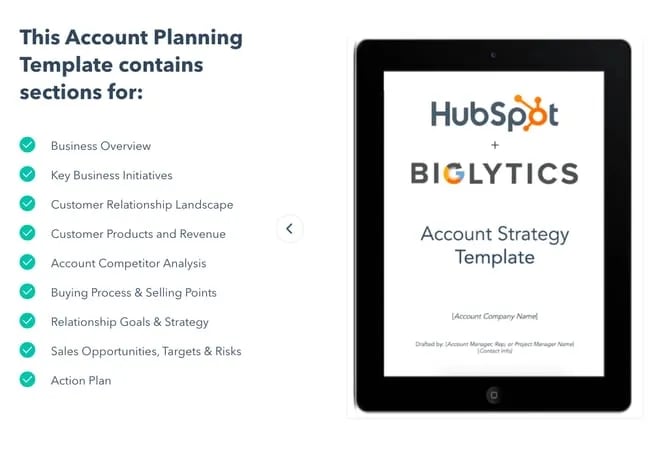
HubSpot’s Account Planning Template is useful for account managers who want the freedom to personalize their account plan with a strong marketing basis.
This template includes all the items discussed before, making it a complete resource for startups and big businesses. It can help small and large teams by providing an actionable step-by-step guide for account managers, sales executives, and marketing professionals to collaborate within the account planning process.
2. Databahn Account Plan Template [XLS]
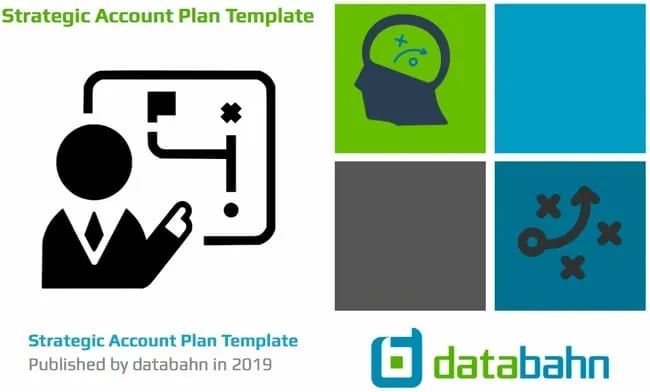
Databahn offers a free Strategic Account Plan template that’s a good option for account management teams trying to streamline their account planning processes. This template is not only easy to use and complete, but it also includes different details like the members of the team, marketing strategies and targets, industry analysis, and annual reports.
Disclaimer: Even when completed, the account planning template needs to be constantly updated to be as effective as possible.
3. Gartner’s Key Account Plan Template
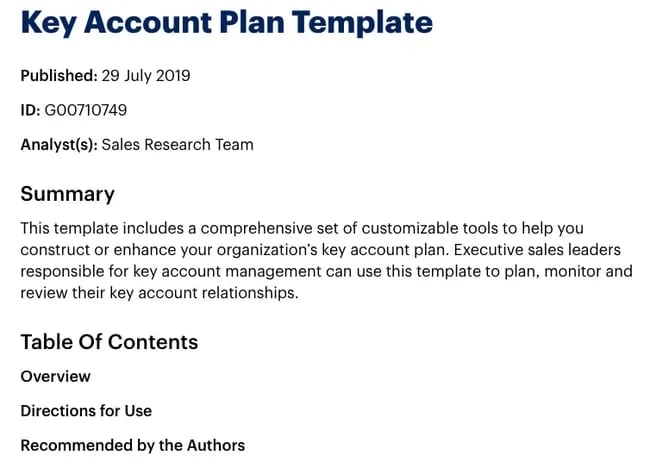
Gartner, the leading information technology research and advisory company, offers a template that includes a comprehensive set of customizable tools to help executive sales leaders construct or enhance their organization’s critical account plan.
4. ForecastEra’s Free Account Planning Template [PDF]
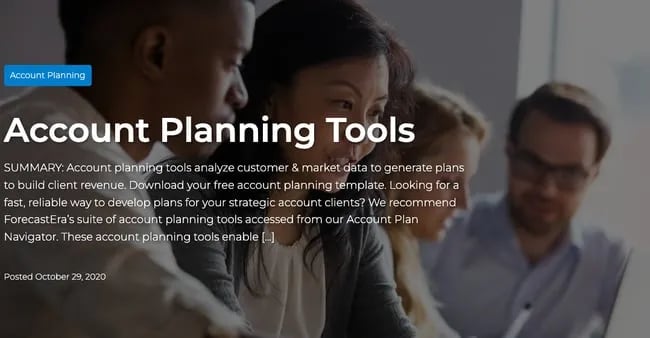
As part of its account planning tools, ForecastEra also offers a free account planning template to help sales executives.
5. Intercom’s Account Plans [XML]
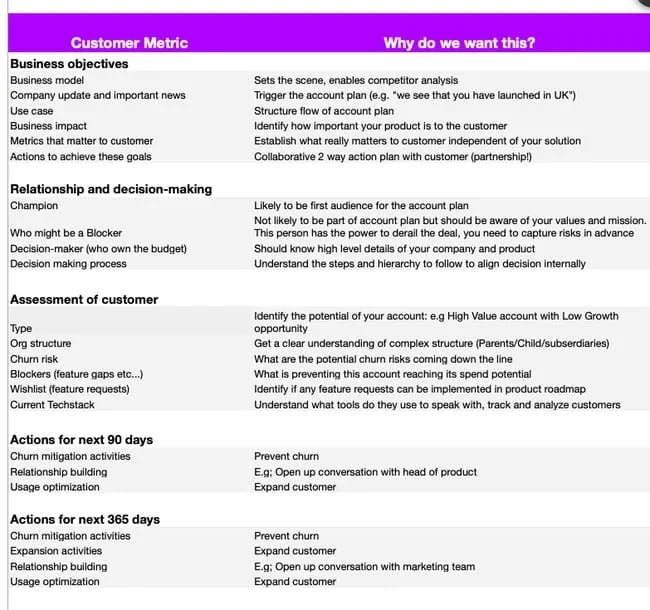
Intercom is a customer success company that works with tools that level up clients relationships.
This company offers an account plan template to help account managers maintain successful customer satisfaction rates by taking advantage of up-to-date information.
6. Unstrategic’s Strategic Account Plan [PDF]
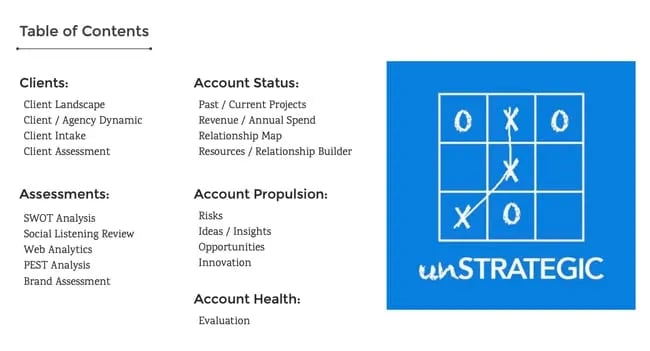
This easy-to-use template is an excellent resource for account managers and sales teams. It offers a detailed solution for companies to work on their account planning without struggling with technical misunderstandings.
This PDF guide offers a user-friendly content display and provides systematic instructions on how to fill out each section. It is great for anyone filling out an account plan for the first time.
7. Revegy’s Account Planning Template
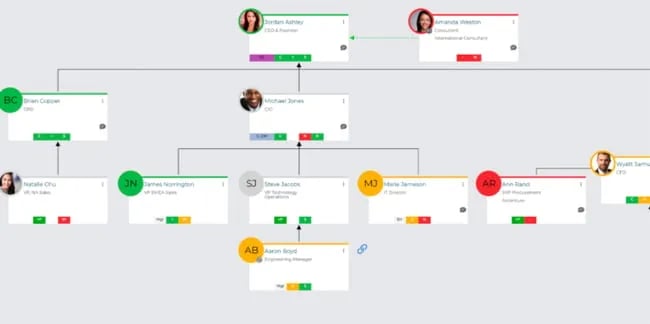
This guide is the best option for sales professionals who want to create effective sales strategies based on customer data.
This tool can help you build consistent account plans that are easy to understand and implement.
8. Avention’s Strategic Account Plan Template [PPT]
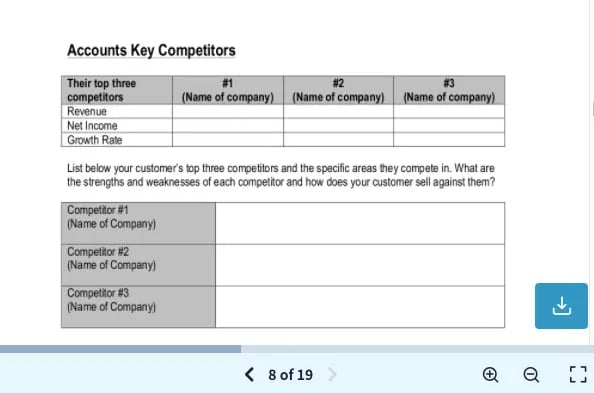
Avention made this template to assist the account management team in staying on top of the client’s business objectives and goals. It’s also helping them achieve desired results that will ultimately have a good impact on the customer’s business.
9. Get2Growth Strategic Account Planning Template [PPT]
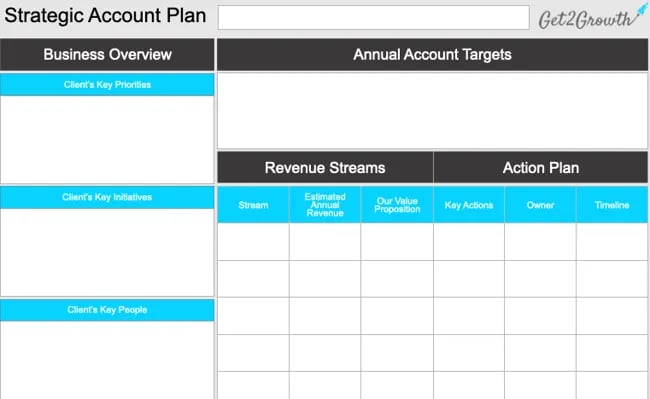
This company offers a one-page detailed template you can use to build an account plan in a few steps.
With different graphic elements and sections, this template is a good solution for account professionals who want to achieve an innovative account managing approach based on quick solutions.
10. Account Planning Template by AccountTips [XSL]
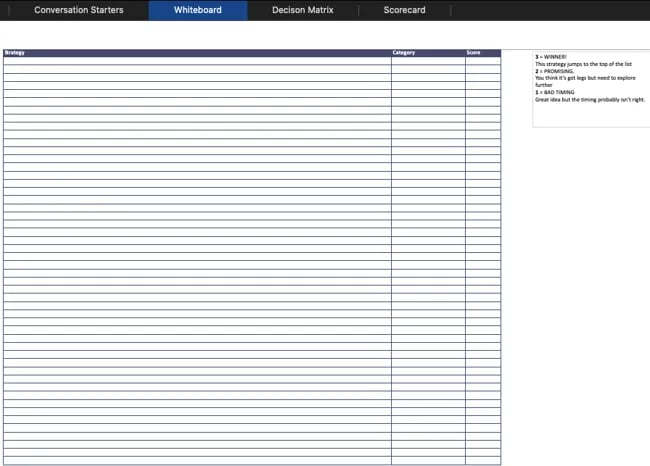
This template is full of helpful resources for account managers, and they offer clearly labeled Excel tabs to level up your account management work.
Supported by articles and academic resources, this template provides both questions to ask and cells to fill with relevant information. You will find yourself finishing your account plan in a blink of an eye.
Supporting Account Planning with Account-Based Marketing Software
Creating an account-based marketing plan (ABM) is the natural next step after finishing the planning process. But there’s no need to do it manually. Instead, we recommend using ABM software that can help you automate your ABM campaigns.
There are a number of different account-based marketing software platforms that can support your efforts, including HubSpot ABM Software, Terminus, and Demandbase.
A high-quality ABM software generally features tools and resources to help you establish a solid foundation for an account planning strategy. It’s typically rooted in defining and understanding your ideal customer profiles (ICPs).
It might also contain features that cover company and contact information, giving you insight into the businesses you're trying to target and the individual decision-makers you need to reach. Other tools — like workflow templates for building and maintaining your ICPs — can also be a big help for successful account planning.

Here's how a workflow looks in HubSpot's ABM software. Specific actions are triggered depending on previous settings, automatically segmenting your ICPs by tier.
Personalization and Engagement
The fundamental basis of ABM, as a concept, is personalization. It's a process rooted in understanding and approaching individual accounts on terms that will specifically resonate with the prospects and customers behind them.
Features designed for compiling lists of target companies with similar characteristics can help you group like-minded companies and contacts for streamlined outreach. Some types of ABM software allow you to send ads to influencers within your targeted accounts across certain platforms — typically LinkedIn.
Resources that allow you to engage with those targeted lists via email can also add value to your account planning efforts. One way or another, it's always in your best interest to reach your target accounts in ways that suit their unique values and characteristics. Finding software to simplify that process can make your outreach more robust without losing focus.
Tracking and Measuring Efforts
Account planning isn't a static process. You need to constantly look for ways to modify your strategy as you interact with more customers. That's why resources to track the efficacy of your efforts are crucial.
Target account reporting libraries can help you keep tabs on target accounts. A solid ABM software often includes resources that let you review internal stakeholders within your target companies, allowing you to see who's supporting, blocking, or influencing your efforts.
It also helps to have visibility into the different interactions your business has with a target company. Some types of ABM software allow you to monitor activity like emails, meetings, and logged calls. Tools like that will enable you to understand where and how to improve your outreach and planning.
How can an ABM support your account plan?
Regardless of the one you choose, ABM software will be a time saver for your sales team, and it will give you the tools to work on your key customer relationships.
You now have all the resources you need to build a successful account plan from scratch, starting with the main questions and all the implementation steps that will help you get there. Are you ready to turn account planning into a valuable asset for your business?
Editor's note: This post was originally published in July 7, 2019 and has been updated for comprehensiveness.
